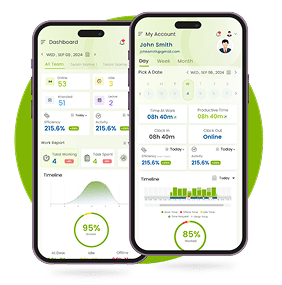Despite rapid advancements in workplace technology, many businesses still rely on manual timesheets like paper forms, spreadsheets, or outdated systems to record employee work hours.
It seems simple and familiar, but here’s the truth: Manual timesheets are costing your business time, money and valuable insights.
Employees spend hours entering data. Managers chase approvals. HR struggles with payroll errors. And in the end, you still don’t get a clear picture of productivity or project progress.
In this post, we’ll break down:
The Hidden Costs of Manual Timesheets
Why Manual Timesheets Fail Modern Teams
The Benefits of Automated Time Tracking
How Desklog Replaces Manual Timesheets
Implementing Desklog: Best Practices for a Smooth Transition
Let’s uncover why it’s time to leave manual timesheets behind and what smarter teams are doing instead with modern time tracking software that automates workflows, improves accuracy and improves productivity.
The Hidden Costs of Manual Timesheets

1. Time Wasted on Data Entry and Approvals
Manual time tracking means every employee must remember what they worked on, record it, and submit it for approval. Then, managers and HR teams review, cross-check and correct discrepancies.
This repetitive cycle consumes hours of productive time each week. For large teams, it adds up to hundreds of wasted hours per month.
2. Payroll Errors and Disputes
Manual entries are vulnerable to mistakes, typos, forgotten tasks, or miscalculations. These small errors lead to incorrect pay, billing disputes and frustrated employees.
When HR teams manually reconcile data across spreadsheets or systems, the chances of human error multiply. Even a minor 1% payroll error rate can cost thousands annually.
3. Lack of Real-Time Insights
Manual systems only provide data after it’s collected, usually weekly or monthly. By the time managers notice productivity issues or project delays, it’s too late to act.
Without real-time visibility, decision-makers can’t track workloads, identify bottlenecks or measure true performance.
Why Manual Timesheets Fail Modern Teams
Today’s workplaces are no longer confined to offices or 9-to-5 schedules. With remote, hybrid, and flexible work, manual timesheets simply can’t keep up.

1. Remote and Hybrid Work Challenges
For remote teams, it’s almost impossible to ensure manual entries reflect actual work hours. Employees may forget to log time accurately or round up estimates, leading to inconsistencies and distrust.
Automated time tracking tools solve this by tracking time in the background, ensuring accuracy regardless of where employees work.
2. Inefficient Reporting for Managers
Managers need quick, accurate insights. Manual systems make it difficult to generate reports or analyze trends, meaning decisions are based on outdated or incomplete data.
Desklog and other automated systems, by contrast, offer real-time dashboards with employee KPIs. You can also view extensive reports.
3. Reduced Employee Engagement
No one enjoys filling out timesheets. It’s tedious, repetitive, and often feels like micromanagement. Over time, this frustration can reduce employee morale and engagement.
By automating tracking, you eliminate this friction, allowing employees to focus on meaningful work instead of paperwork.
The Benefits of Automated Time Tracking
Automated time tracking tools like Desklog have completely changed how modern teams measure work, productivity and efficiency.

1. Accuracy and Reliability
Automated tracking eliminates manual entry errors. Every minute spent at work, on a task or project is logged precisely, giving you accurate data for payroll, billing, and performance analysis.
2. Real-Time Productivity Insights
Unlike manual systems, automated tools provide live dashboards that visualize how time is spent across projects, apps, and tasks. These insights empower managers to make data-driven decisions, improving efficiency.
3. Reduced Administrative Burden
When tracking happens automatically, HR and managers spend less time chasing data and more time analyzing results. Employees are freed from tedious forms, and payroll runs faster with fewer errors.
How Desklog Replaces Manual Timesheets
Built for businesses that value time efficiency, transparency, and productivity, Desklog replaces outdated manual systems with intelligent automation and real-time analytics that empower both managers and employees.
Automated Time Tracking That Simplifies Management
Desklog’s automated time tracking system includes features such as:
Clock-in/Clock-out tracking to log employee login and logout times
Offline tracking for uninterrupted data capture even without an internet connection
Every tracked activity is automatically recorded in digital timesheets, ensuring precise records for payroll, invoicing, and project costing.
Automated Timesheet Feature
Desklog includes an Automated Timesheet function: the system auto-generates timesheets from captured work data, eliminating the need for employees to fill out manual timesheets. Desklog also outputs daily, weekly or monthly templates in Excel format, ready for payroll or review.
Detailed Reporting and Analytics
Where manual systems offer raw data at best, Desklog provides real-time dashboards and customized reports that visualize productivity across teams, projects, and time periods. Managers can easily:
Compare performance between employees or teams over time
Identify trends, inefficiencies, and workload imbalances
Make informed decisions based on actual data rather than assumptions
Integrated Time, Project and Billing Management
Manual systems often require juggling multiple spreadsheets or tools for time tracking, project management, and client billing. Desklog consolidates all these into one unified platform. It supports both billable and non-billable hours with flexible billing options, enabling businesses to invoice clients accurately based on real work hours.
Project Time Tracking and Visualization
Managing projects through manual timesheets often leads to confusion and inaccurate billing. Desklog’s Project Time Tracking feature provides real-time insights into every stage of a project, automatically recording hours spent on each task or milestone.
The Kanban view offers a clear, visual snapshot of project progress, enabling teams to track workloads, deadlines, and billable hours effortlessly. This ensures that every client is billed fairly and every project stays on schedule.
Insights: Smarter Performance Comparison Over Time
One of Desklog’s most powerful advantages over manual timesheets is its Insights feature. This tool takes time-tracking data and turns it into performance analytics. Managers can:
Compare individual and team productivity over any period
Identify performance improvements or declines
Understand how workflow changes affect output
Recognize top performers and employees who may need support
Implementing Desklog: Best Practices for a Smooth Transition
Switching from manual to automated time tracking doesn’t have to be disruptive. Follow these best practices to ensure smooth adoption.

1. Onboarding Teams for Automated Tracking
Start small. Roll out Desklog to a pilot team first. Provide training on features, privacy settings, and how data is used. Encourage open feedback to build trust and confidence.
2. Setting Clear Productivity and Focus Goals
Use Desklog’s dashboards to set measurable goals for productivity, focus time, and project milestones. Review progress regularly and celebrate improvements to keep motivation high.
3. Maintaining Employee Trust
Transparency is key. Clearly communicate what data is tracked and how it benefits employees (e.g., reducing admin work, ensuring fair pay). Desklog’s ethical tracking approach ensures privacy and fairness for all.
Conclusion
Manual timesheets may have once done the job, but today, they’re holding teams back. The time lost to manual entry, payroll errors, and lack of visibility directly impacts productivity and growth.
Modern teams need real-time insights, accuracy, and automation, and that’s exactly what Desklog delivers. With features like automated time tracking, auto-generated timesheets, and performance insights, Desklog takes time tracking from an administrative burden into a powerful productivity tool.
FAQ
1Why are manual timesheets still used by many businesses?
Many companies continue to use manual timesheets because they’re familiar and easy to start with. However, they often underestimate how much time and accuracy they lose through human error, missing entries, and administrative effort.
2What are the biggest problems with manual timesheets?
Manual timesheets are error-prone, time-consuming, and lack real-time visibility. They cause payroll inaccuracies, billing disputes, and make it harder for managers to measure productivity or project progress accurately.
3What is Desklog’s Automated Timesheet feature?
Desklog’s Automated Timesheet feature auto-generates daily, weekly, or monthly timesheets based on real tracked data.
4Can Desklog help reduce payroll errors?
Yes. Since Desklog automatically records exact work hours and attendance, it ensures that payroll calculations are precise and transparent, minimizing disputes and miscalculations.
5Is Desklog suitable for remote or hybrid teams?
Absolutely. Desklog was designed for modern, flexible workplaces. It captures work activity whether employees are in the office or remote, providing real-time visibility for managers without micromanaging.
6What kind of productivity insights does Desklog provide?
Desklog offers real-time dashboards, reports, and an Insights feature that lets managers compare employee performance over time. It helps identify top performers, productivity trends, and areas for improvement.
7Does Desklog track employees ethically?
Yes. Desklog emphasizes transparency and privacy. Businesses can customize tracking levels, share data policies openly with employees, and use insights responsibly, ensuring productivity tracking without surveillance.

















